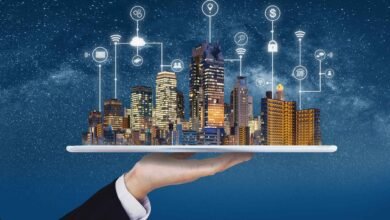The Rise of Edge Computing and Its Impact on Data Processing

Introduction
In today’s hyper-connected world, the sheer volume of data generated is staggering. Traditional cloud computing struggles to keep up with the demand for real-time processing and decision-making. Enter edge computing—a revolutionary approach that processes data closer to its source, reducing latency and enhancing efficiency. As industries increasingly adopt this technology, edge computing is becoming a cornerstone for modern applications, from smart cities to autonomous vehicles. This article explores the rise of edge computing and its profound impact on data processing.
What is Edge Computing?
Edge computing refers to the practice of processing data at or near its source, rather than relying solely on centralized data centers. By bringing computation closer to where data is generated, edge computing reduces the need to transfer large volumes of data to remote servers, minimizing latency and bandwidth usage. This localized approach enables faster decision-making, making it ideal for applications that demand real-time processing.
Key characteristics of edge computing include:
- Proximity to Data Sources: Processing happens at the edge of the network, such as IoT devices or local servers.
- Reduced Latency: Faster response times by eliminating delays associated with cloud-based data centers.
- Enhanced Security: Sensitive data can be processed locally, reducing exposure to cyber threats.
- Bandwidth Efficiency: Lower data transmission requirements optimize network usage.
See also: Internet of Things Revolution: Connecting the Future
How Edge Computing Differs from Cloud Computing
While cloud computing relies on centralized data centers to store and process information, edge computing decentralizes these functions.
| Feature | Edge Computing | Cloud Computing |
|---|---|---|
| Data Processing Location | At the data source or nearby | Centralized data centers |
| Latency | Low | Higher for time-sensitive tasks |
| Bandwidth Usage | Minimal | Significant |
| Real-Time Applications | Highly suitable | Limited |
The two approaches are complementary, with edge computing handling time-critical tasks and the cloud managing large-scale data storage and analysis.
Applications of Edge Computing
1. Internet of Things (IoT)
Edge computing powers IoT devices by processing data locally, enabling real-time responses and reducing reliance on the cloud. Smart homes, wearable devices, and industrial sensors all benefit from this approach, improving performance and user experience. For instance, a smart thermostat can instantly adjust settings based on local temperature readings without needing to communicate with a distant server.
2. Autonomous Vehicles
Self-driving cars rely on edge computing to process sensor data in real-time. Functions like object detection, route optimization, and obstacle avoidance require split-second decisions, which centralized data centers cannot deliver efficiently. By processing data at the edge, autonomous vehicles ensure safety and responsiveness.
3. Smart Cities
From traffic management to public safety, edge computing plays a vital role in building smarter cities. Traffic lights can adjust to real-time congestion levels, while surveillance systems analyze video feeds locally to detect suspicious activities. This localized processing reduces latency and enhances the efficiency of urban systems.
4. Healthcare
In healthcare, edge computing enables remote patient monitoring and faster diagnosis. Wearable medical devices equipped with edge capabilities can analyze patient vitals in real-time and alert healthcare providers in emergencies. Hospitals also use edge systems to optimize workflows and reduce latency in critical operations.
5. Industrial Automation
Manufacturing plants use edge computing to monitor equipment, predict maintenance needs, and optimize production processes. By analyzing data from sensors on-site, companies can avoid costly downtime and improve operational efficiency.
6. Gaming and Augmented Reality (AR)
Edge computing enhances the gaming experience by reducing latency and ensuring seamless interactions in AR applications. Gamers benefit from real-time responses, and AR systems process visual data locally for smooth user experiences.
Benefits of Edge Computing
1. Reduced Latency
By processing data closer to its source, edge computing eliminates delays caused by transmitting data to and from cloud servers. This is critical for applications like autonomous vehicles and industrial automation, where milliseconds can make a difference.
2. Improved Reliability
Edge systems are less dependent on stable internet connections, ensuring continued functionality even during network disruptions. For instance, in remote areas, edge devices can operate independently and synchronize with the cloud when connectivity is restored.
3. Cost Efficiency
Reducing data transmission to centralized servers lowers bandwidth costs. Additionally, processing data locally minimizes the need for expensive cloud storage solutions.
4. Enhanced Security
Local data processing reduces the exposure of sensitive information to cyberattacks. Organizations can implement security measures tailored to specific edge environments, ensuring better protection for their data.
Challenges in Edge Computing
While edge computing offers numerous advantages, it also comes with challenges:
- Scalability: Managing numerous edge devices across diverse locations is complex.
- Data Synchronization: Ensuring consistent data between edge devices and cloud systems can be challenging.
- Infrastructure Costs: Deploying and maintaining edge devices require significant investment.
- Cybersecurity Risks: While edge computing enhances security, edge devices themselves are potential targets for attacks.
- Skill Gap: Implementing and managing edge computing systems require specialized expertise.
Top Edge Computing Technologies and Providers
Several companies are leading the edge computing revolution:
- Amazon Web Services (AWS): AWS offers services like AWS IoT Greengrass for edge computing solutions.
- Microsoft Azure: Azure IoT Edge integrates cloud intelligence into edge devices.
- Google Cloud IoT: Provides tools for edge device management and data processing.
- Edge AI Startups: Companies like FogHorn and Edgeworx are innovating in edge AI.
Future of Edge Computing
As the demand for real-time processing grows, edge computing is set to play an even more significant role in various sectors. The rise of 5G networks will further enhance its capabilities, enabling faster data transfer and more efficient edge systems. Future advancements may include:
- Edge AI Integration: Combining artificial intelligence with edge systems for smarter decision-making.
- Edge-Oriented Development: More applications designed specifically for edge environments.
- Interconnected Ecosystems: Seamless collaboration between edge, cloud, and IoT systems.
FAQs
1. How does edge computing improve IoT?
Edge computing processes data locally, enabling faster responses and reducing dependency on cloud systems. This improves performance and efficiency in IoT devices.
2. What industries benefit most from edge computing?
Industries like healthcare, transportation, manufacturing, smart cities, and gaming gain the most from edge computing due to their need for real-time processing.
3. Is edge computing a replacement for cloud computing?
No, edge computing complements cloud computing by handling time-critical tasks locally, while the cloud manages large-scale data storage and analysis.
4. What are the key challenges in edge computing?
Challenges include scalability, data synchronization, infrastructure costs, cybersecurity risks, and the need for specialized expertise.
5. How does edge computing support autonomous vehicles?
Edge computing processes sensor data in real-time, enabling split-second decisions for functions like object detection and route optimization.
6. What role will 5G play in edge computing?
5G networks will enhance edge computing by enabling faster data transfer, reduced latency, and improved connectivity for edge devices.
Conclusion
Edge computing is transforming the way data is processed, bringing computation closer to where it’s needed most. By reducing latency, enhancing security, and improving efficiency, it’s reshaping industries and paving the way for a smarter, more connected future. As advancements in edge computing continue, its integration with technologies like IoT, AI, and 5G will unlock even greater possibilities, solidifying its role as a cornerstone of modern innovation.



